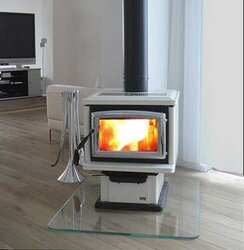After several years of wanting a wood stove my wife and I are finally in a position to buy one. This Friday (Christmas Eve no less) we are having an Alderlea T5 installed. I'm pretty decent with tile so to save a bit of money I agreed to build the floor protector. After downloading and reading the T5 manual I'm left with a few questions. The manual states: "The stove may be installed on a combustible floor provided noncombustible ember protection
is used." What I don't see are any specifics related to the r or k values of the assembled floor protector.
Does anyone know what the requirements are for ember protection in terms of thermal conductivity? I have purchased 1/2" Durock (NexGen) and was planning on one layer of this topped off with porcelain tile but after reading the many posts regarding Durock and r values I'm lost. The only information I can find for Durock Next Gen is data on the product label (UL Classified and classified in accordance with ASTM E136).
I'm in extreme north-east Tennessee and builiding codes are almost non-existant and inspectors even more rare. Can someone also please suggest the proper code to follow for construction of an ember protection device?
Kind Regards.
Dan
is used." What I don't see are any specifics related to the r or k values of the assembled floor protector.
Does anyone know what the requirements are for ember protection in terms of thermal conductivity? I have purchased 1/2" Durock (NexGen) and was planning on one layer of this topped off with porcelain tile but after reading the many posts regarding Durock and r values I'm lost. The only information I can find for Durock Next Gen is data on the product label (UL Classified and classified in accordance with ASTM E136).
I'm in extreme north-east Tennessee and builiding codes are almost non-existant and inspectors even more rare. Can someone also please suggest the proper code to follow for construction of an ember protection device?
Kind Regards.
Dan


